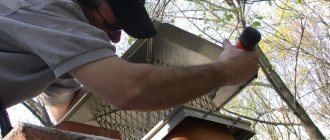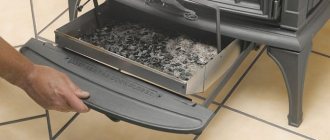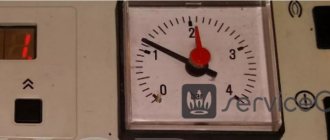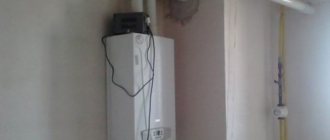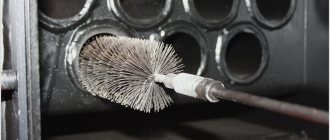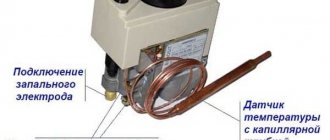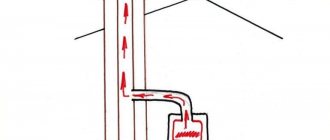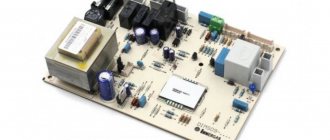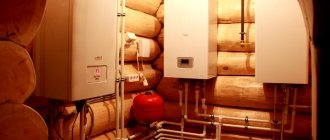The accumulation of carbon monoxide is harmful to humans and can be fatal. To avoid poisoning, the air pressure must be constant. The draft sensor of a gas boiler helps determine the intensity of suction and turns off the device if it is absent.
The draft sensor monitors the air vacuum level
Description and purpose of the traction sensor
The safety element ensures safe operation of the equipment. The draft sensor of a suspended and floor-standing gas boiler is responsible for turning off the device when carbon monoxide accumulates. The presence of sufficient draft in the device ensures the replacement of combustion products with fresh air, which ensures safety.
The function of the draft sensor is to send a message to the system valve that the air vacuum is insufficient and an intense accumulation of carbon monoxide may occur. As soon as a draft violation message is received, the valve turns off the device.
Insufficient exhaust air suction leads to the phenomenon of “backdraft”. The release of combustion products does not occur through the chimney channels, but into the room in which the equipment is installed.
What elements need to be checked?
First of all, the elements that are indicated by the nature of the malfunction must be checked. For example, if the column turns off, the culprit may be a clogged heat exchanger or a problem with the draft sensor. If the water heater stops igniting, the problem often lies in the thermocouple or solenoid valve. It also happens that water starts leaking from the water heater due to a leak in the water block. Let's look at how to properly check the functionality of some elements of a gas water heater.
Read here how to properly flush a gas water heater
Checking the traction sensor
The draft sensor performs an important function in the column - it monitors that carbon monoxide does not enter the room. Ideally, the chimney or ventilation shaft should perfectly remove all flue gases. However, it happens that the draft is disrupted due to the pipe being clogged with debris or soot, then smoke begins to enter the room. To prevent this from happening, each water heater has a draft sensor. It is located in a place that is located between the ventilation duct and the device body. The type of sensor depends on the type of combustion chamber of the gas water heater:
- in a chimney water heater, the draft sensor is a metal plate to which a contact is made;
- in a turbocharged column, products are removed through a ventilation hole or a coaxial chimney; The traction sensor is a pneumatic relay with a membrane.
If the traction sensor is triggered, the reason may be:
- poor traction - occurs due to pipe breakdowns;
- reverse draft - occurs when an air plug appears in the channel; the smoke does not come out as expected, but comes back;
- chimney blockage - bird's nests, soot, leaves, etc. can get into the chimney;
- strong wind - if there are errors in the installation of the pipe, then strong gusts of wind blow into it and extinguish the burner - as a result, the draft sensor is triggered.
This element is vital, and if it fails, the consequences can be disastrous. Therefore, if you notice that the traction sensor has stopped working, you need to urgently check its functionality and, if necessary, repair it. There are several methods for checking the operation of geyser sensors:
- attach the mirror in the place where the sensor is installed - if during operation it does not fog up and remains clean, then the element is working;
- shut off the hood with the damper while the unit is operating - during normal operation, the sensor should immediately trigger and turn off the column.
But it happens that the draft sensor turns off the water heater for no apparent reason. In this case, you can check the serviceability of the sensor using an ohmmeter. To do this, the sensor is disconnected and its resistance is measured. It should be equal to infinity. If this is not the case, then the part has failed. In this case, the traction sensor will have to be replaced.
Note! Irresponsible owners of water heaters, having discovered that the draft sensor turns off the column for no reason, simply disconnect it. But it is dangerous to do this, because if an emergency occurs, the water heater will continue to operate and carbon monoxide will enter the room.
The presence of draft in the chimney or ventilation duct can be easily checked using a thin paper strip held near the hole:
- if it is pulled inward, then there is a craving;
- if it does not move or deviates from the vent, then there is no draft.
How to test a thermocouple
The thermocouple on the geyser performs an important function - it controls the temperature and provides protection against overheating. The thermocouple works as follows - heated by the burner flame, it generates an electric current and holds the solenoid valve open. When the fire goes out, the thermocouple cools, the current stops being produced and the valve closes. Then the fuel supply stops to both the main and pilot burners.
In devices with piezo ignition, the thermocouple is often subjected to prolonged exposure to fire, as a result of which it is gradually destroyed. This is due to the fact that turning on such geysers is quite difficult and time-consuming. The destruction of the thermocouple leads to the fact that after releasing the fuel supply adjustment knob, the flame goes out. The condition of the element can be checked by removing the device housing and touching the thermocouple. If the metal peels off from it, the part needs to be replaced. It also happens that the thermocouple becomes clogged with carbon deposits and soot, but this problem can be corrected by cleaning.
How to test a microswitch
The microswitch is the weak point of Chinese water heaters with electronic ignition. A sign of a problem with the microswitch is that when the hot water tap is opened, the heater does not light up. However, this is a symptom of other problems. First, it is better to check the battery charge and the water block membrane. If everything is in order with them, then they move on to checking the microswitch. It, like the membrane of the water unit, is subject to wear. Each time the water heater is started, the water block rod moves the microswitch contacts, so over time they fail.
Let's look at how to check the geyser microswitch for serviceability. Remove the plug from the wire leading to the element and close the contacts with a screwdriver. After this, you need to open the hot water tap and check whether the burner of the column lights up. If the water heater starts working, then the problem is with the microswitch and it needs to be replaced.
The principle of operation of the draft sensor in a gas water heater
Combustion products from the firebox flow through the chimney to the street. If the level of air suction in the duct is reduced, smoke occurs in the room. The room is filled with carbon monoxide, which has a detrimental effect on humans. Poisoning from its vapors can lead to suffocation.
Attention! If carbon monoxide has accumulated in the room, it is necessary to intensively ventilate the apartment (open all windows), close the doors to adjacent rooms and call gas specialists.
The draft sensor consists of:
- bimetallic plate;
- plugs;
- nuts;
- fitting.
The bimetallic relay signals the shutter valve to turn the boiler system on or off.
The thermal relay consists of a bimetallic plate with movable contacts
The temperature of the exhaust gas located in the chimney depends on the intensity of fresh air suction. The better the traction, the lower it is. When heated, the bimetallic plate expands, which leads to disconnection of the contact when the temperature reaches a critical value.
Gas boilers operate on natural and liquefied gas. In the first case, the normal range is considered to be 75-950 0C. In the second case, adequate operation of the boiler occurs when the gas is heated within the range of 75-1500 0C.
The calorie content of liquefied propane butane gas is higher than natural gas. Therefore, the combustion temperature also increases. The thermal relay is set to turn off at 950 0C for natural gas and at 1500 0C for propane-butane devices.
The draft sensor of the AOGV gas boiler is located in the area of action of the wick and is connected to the electromagnetic element of the circuit, which opens the gas supply.
The gas supply control circuit of the AOGV boiler requires the presence of a temperature sensor
The thermocouple electrode is located near the igniter. While it is heating up, the gas supply does not stop. As soon as the electrode has cooled, the supply is closed.
How to check a draft meter for a gas water heater: finding and removing breakdowns
From the author: hello, friends! water heater is a rather complex structure that consists of many components. Any of them plays an important role in the operation of the device. If some of these elements malfunction, the failure is immediately visible; this does not require any testing. And here is a draft meter for a gas water heater
how to check? And why is this detail necessary at all? This is actually what we will talk about in this article.
In general, water heater is an excellent heating device. It is not for nothing that it is the most common among owners of both apartments and privatized houses. The boiler is more efficient, does not require overly complex maintenance, and the fuel used in most cases costs literally pennies.
The only disadvantage of this equipment is the supposed danger of its operation in the event of any breakdowns. Everyone knows that a gas leak, for example, usually has terrible results, even leading to an explosion, destruction of the house and death of people. Thanks to this, any component of the column should work perfectly, every breakdown should be corrected here, and a part that is completely out of order must be replaced.
Because of this, it is very, very important to identify the problem in time. For this purpose, constant checks of the system are carried out, and they are mainly carried out by gas service professionals. But you personally can sometimes examine some details; the safety of the people living in the house depends on them. One of these parts of the structure is considered to be a traction meter.
Types of traction sensors
The relay device is distinguished according to the principle of operation of the combustion chamber. There are 2 types of construction: open and closed. A draft sensor operates in a gas boiler with an open view of the combustion chamber. Install it in the smoke eliminator. The gas supply stops if the bimetal exceeds the expansion rate, breaking the contact in the circuit. The valve reacts to the signal and blocks movement to the igniter.
Boilers with an open combustion chamber pose a danger in the form of reverse draft. It occurs if:
- the chimney is clogged with debris and rubbish;
- A strong gusty wind is blowing, which blows the system.
In this case, carbon monoxide smoke is drawn from the chimney into the room. The traction sensor is not designed for such cases, so experts additionally advise installing a gas sensor. This will prevent accidents from occurring.
In gas boilers with a closed type of combustion chamber, a pneumatic relay is installed. Its job is to control the fan, which creates forced draft and helps draw combustion products into the chimney and discharge them outside.
There are wired and wireless sensors. The first alarms require additional installation to the wire connections. Wireless relays operate from a radio signal. Such sensors are installed in cases where the operation of the device is monitored from another room.
The wireless alarm system consists of 2 blocks. The first is installed near the boiler and connected to its terminals, and the second - in the room from which the equipment is controlled. These blocks are connected by a radio signal. The controller is equipped with a keyboard and display for easy operation.
Based on the functions they perform, thermostats are divided into simple and programmable. The first relays perform only one task: monitor the set temperature. Programmable alarms can perform the functions necessary to analyze the operation of the boiler remotely:
- setting the temperature regime for daytime and nighttime operation;
- programming the device by day of the week;
- monitoring indoor humidity (in this case, the device is additionally equipped with a hydrostat);
- maintaining a given humidity parameter.
The type of draft sensor depends on the operating principle of the gas boiler
Incorrect placement of the chimney contributes to the wind blowing in and extinguishing the burner. To prevent such cases from occurring, experts advise additionally installing a stabilizer.
The best ways to test traction
For correct operation of geysers with an open combustion chamber, you will need good draft and proper arrangement of the chimney. Most modern models are equipped with an automatic safety system that prevents the device from starting if there is no traction.
Next, we’ll look at how you can check the draft in the chimney of a domestic gas boiler and water heater.
Method #1 - using an anemometer
A professional check of the draft in the chimney of a gas boiler and water heater is carried out using a special measuring device - an anemometer.
With its help, you can verify the presence of air traffic and determine its strength. The indicator should be 1.96-29.40 Pa.
Method #2 - using a match
If it is not possible to use an anemometer, you can check as follows:
- Prepare paper strips and secure them at the entrance to the mine channel. You must first remove the horizontal part of the chimney pipe. The movement of part of the leaf will signal the presence of traction.
- Sufficient draft can also be determined using a flame. A lit match should be directed vertically towards the viewing window on the front panel of the water heater.
The chimney should be checked before igniting the water heater. A flame brought to the inspection hole at the top of the column during operation should be drawn inward.
Method #3 - checking the traction sensor
The water heater has several control modules installed. Sensors for overheating, draft, ionization, and water pressure prevent emergency situations.
The draft sensor monitors the temperature of the exhaust gases, and when it increases, it reacts accordingly:
- Inside the sensor there is a bimetallic plate connected to the gas valve.
- Metal expanding as a result of overheating transmits a signal to turn off the gas supply.
- The cooled plate returns to its original dimensions, opening the valve.
It is recommended to check the serviceability of the sensor when systematically turning off the column.
You can do this in several ways:
- place a mirror next to the sensor, its surface should not sweat when the water heater is turned on;
- The serviceability of the sensor will be indicated by turning off the gas water heater when the chimney is closed 2/3 with the damper.
In some water heater models, the regulator is mounted on a plastic mount that can be easily moved out of place. This will also lead to frequent speaker shutdowns.
You can also test the serviceability of the sensor using an ohmmeter; its resistance should be equal to infinity. Otherwise, the part should be replaced.
When there is a constant interruption in the fuel supply, home owners often simply turn off the sensor, after which the water heater actually starts working without interruption. But such a decision violates the safety precautions for operating gas equipment. The water heater will remain unprotected; if there is a leak, carbon monoxide will enter the room.
It is strictly prohibited to use a gas water heater if there is no vacuum in the chimney channel. Let's consider the possible reasons for the lack of traction.
How to install a gas boiler draft sensor
Experts recommend installing heating equipment in a separate room. To do this, choose the coldest room without radiators. The draft sensor is installed on the gas boiler. The heater is located in a place protected from sunlight. Also, the room should be away from drafts. The building cannot be located in a windy area to avoid the possibility of burner extinguishing.
Using a terminal, a thermostat is attached to the gas boiler. If it is necessary to install additional equipment, study the instructions from the manufacturer. Different boiler models have their own installation nuances, so it is important to follow these recommendations.
The thermal relay is installed using clamps that extend from the thermostat or heat exchanger
If the device needs to be placed outside the speaker housing, it is released from the front panel. At the installation site, prepare a recess according to the dimensions of the relay, and provide the box with a lid so that it is possible to replace the element if it breaks.
Attention! Experts recommend removing the thermostat when installing heated floors in order to monitor the performance of the system.
The heating cable is connected to the contacts, and the sensor to the terminals. Attach the power cord and perform packaging. The front panel is placed on top and closed with a lid.
Checking the gas boiler draft sensor
The thermal relay is replaced if the normal functioning of the device is disrupted. If no problems are found in the chimney, and nothing prevents the exit of combustion products, and the boiler constantly turns off, specialists check the working condition of the alarm.
You can check the draft sensor of a gas boiler with a multimeter and other methods:
- Install a mirror near the relay. If the boiler becomes wet during operation, the sensor is faulty.
- The chimney is not tightly covered with a damper. If the thermostat is working properly, the heater turns off.
- When checking the pneumatic relay of a double-circuit device, turn off the heating system, leaving the workers only heating hot water, and open the tap. If the system turns off, then the problem is with the thermostat.
Check the serviceability of the thermostat with a multimeter
All types of alarms are used for various modifications of wall-mounted and floor-mounted heating devices.
Nuances of checking sensors and possible malfunctions
In order for the sensors to work properly, they must be constantly monitored. Thus, the main causes of breakdowns and failure of sensors can be:
- The sensor is dirty with dust, soot or scale. Each of the contaminants negatively affects the operation of the protection system. This can be corrected by simple cleaning.
- The sensor may have melted or reached the end of its expiration date. Only a complete change of the protection system will help here.
- Weather conditions may interfere with sensor operation. For example, heavy snowfall or rainfall can flood the traction sensor responsible for gas supply.
Gas water heater sensors may fail due to dust contamination
To check the sensors for malfunction, there are two ways. Both of them are quite simple, but at the same time effective and can be carried out without special devices.
In the first case, you need to use a mirror. Attach it next to the sensor. If it doesn't fog up, it works properly. Otherwise, you should contact your gas service.
The second method is to cover the cravings. The sensor should “feel” this and stop supplying gas to the wick.
If, after checking all this, experiments show that the sensors are working properly, then the problem is in the control element. It is best to replace the element, since most often it turns out to be faulty.
Thus, you expose yourself, loved ones and others to danger, which may be fraught with consequences in the future. However, with this way out of the situation, the column works uninterruptedly, but is unsafe for you.
Reasons for triggering the traction sensor
Problems with the actuation system or wind may cause the system to shut down. The most common reasons for the thermostat to trip:
- gusty wind;
- chimney blockage;
- incorrect installation of the boiler or chimney, incorrect calculations;
- fan shutdown.
Gusty wind
To prevent a gust of wind from extinguishing the burner, experts recommend installing a stabilizer. It is mounted at the outlet pipe.
Chimney blockage
Debris in the chimney serves as an obstacle to the removal of combustion products. The draft is reduced, and carbon monoxide is not released into the street. The system overheats and the device shuts down. In this case, the problem is eliminated by cleaning the chimney.
Incorrect installation
If errors were made in calculations or installation during installation. Carry out control measurements and check the correct installation of the boiler and chimney. The height of the outlet is calculated depending on the location of the pipe from the ridge. Experts recommend placing it in the center of the roof. The head is placed 50 cm above the ridge.
Disabling the fan
Turning off the fan stops the supply ventilation, and carbon monoxide is not discharged to the street. In this case, the reason for stopping the operation of the ventilation system is identified.
Experts recommend performing a seasonal preventive inspection of the heating device in the fall and spring. Operating the boiler without a thermostat is not recommended.
How to repair a gas water heater
Since sooner or later there will definitely come a time when a home hot water heater begins to act up or refuse to work altogether, it would not hurt for users to know what to do in this or that case. Depending on the malfunction, you can carry out some repairs of geysers yourself or call a specialist. The last action is most preferable, since the heater belongs to gas-using installations, and therefore is a source of increased danger. This article will outline what problems you can fix yourself and how to do it correctly.
Speaker malfunctions
Let’s immediately make a reservation that we will consider the problems of flow-through heaters with an open combustion chamber, of which there are a great many installed in apartments and houses. We will bypass the repair of fully automated turbocharged dispensers with power supply from the mains and ignition from a hydrogen generator. These devices are quite complex and intervention in their design by an ignorant person is contraindicated. Troubleshooting of supercharging units should be carried out by service or gas services.
The list of malfunctions inherent in geysers after several years of operation is as follows:
- smell of gas;
- problems with ignition and starting of the main burner;
- turning off the heater during operation;
- various leaks.
If you smell gas, whether constantly or periodically, you must immediately turn off the appropriate tap, open the windows and call the emergency service. Explain to the dispatcher the nature of the problem, and he will make a decision - to urgently send a team to your home or simply send a technician on a first-come, first-served basis. There are no other options; fixing methane leaks on your own is strictly prohibited.
Problems with ignition
There are two types of ignition systems for atmospheric heaters; we will analyze them separately:
- manual, with a spark from a piezoelectric element;
- automatic, battery powered.
For reference. The most modern models of dispensers are ignited automatically from the energy generated by a hydrogenerator. Everything here is relatively simple: if the ignition does not work, then the culprit is weak pressure in the water supply, or the generator itself has failed.
With the manual ignition method, sometimes a malfunction of the gas water heater is observed, such as failure of the thermocouple. Then, when the regulator or button is released during ignition, the wick that was just burning goes out again. The fact is that the temperature-sensitive element must heat up from the igniter while you hold the handle and apply current to the solenoid valve. The latter will hold the mechanism for you when you release it. If this does not happen, then the contact in the circuit is broken or the thermocouple must be replaced. To perform this operation, it is better to invite a specialist.
As for automatic ignition systems, malfunctions of geysers during the ignition process are not limited to low batteries, as is written on many Internet resources. In addition, any more or less modern model of heater, even Russian-made, is equipped with an electronic low battery indicator. So the user knows when it is time to change them.
The device will not even begin the process of igniting the igniter until the hot water tap opens and the required pressure appears in the network. When there is not enough of it, the column will not show any signs of life. The same thing will happen if there is insufficient gas pressure or after a shutdown as a result of the draft sensor being triggered (until it cools down). It is better for a specialist from the relevant service to deal with poor gas pressure; you will not be able to do this yourself.
Since we are considering internal malfunctions of the column, we can name a clogged mesh at the entrance to the water unit as the culprit of low water pressure. If the charge of the batteries is normal, the water and gas pressure is sufficient, and the heater makes clicks of a spark discharge, but the matter does not go further, then move on to the next section.
The main burner does not start
One of the main devices guarding the safety of the unit is the water unit (in simple terms - “frog”). If there is sufficient water pressure, the frog uses its rod to press the gas valve actuator and it supplies fuel to the main burner (in conventional columns). In automatic heaters, the water unit allows access of fuel to the igniter, and the supply of gas to the main nozzles is already a function of the gas unit.
When the water unit is faulty, fuel will not be supplied to the burner, and in the case of automatic heaters, to the igniter. It happens that when the hot water valve is opened to maximum, the frog still works, but this only indicates the presence of small cracks in the working diaphragm. You can bring the device back to life with your own hands; to do this, you need to purchase a repair kit and change the membrane, which will be discussed below.
There are often situations in which the wick ignites, but burns poorly and weakly. If you look closely, you will notice that the color of the fire is yellow rather than blue. When fuel is supplied to the main burner, popping noises are heard due to the fact that it does not flare up immediately and has time to fill the combustion chamber. Here, to repair the column, you need to clean the tube and igniter nozzle. The latter in many models can be easily removed and cleaned, as shown in the video:
Important! You cannot insert steel wire into it to clean the wick. You only need to use thread and a thin wooden stick moistened with kerosene.
Burner switches off during operation
A malfunction of the same water unit can also lead to a cessation of gas supply during the combustion process. With high pressure, a frog with a worn membrane can still cope somehow, but if you open cold water, the pressure drops and the gas water heater goes out. The same consequences occur when the traction sensor fails. The temperature-sensitive element is designed to break the electrical circuit when its surface reaches a certain temperature. The sensor is installed near the flue gas outlet and connected to the solenoid valve by wires.
As soon as the draft in the chimney disappears, the temperature of the flue before leaving the duct will increase sharply, the sensor will heat up and break the circuit. The electric valve, in turn, will shut off the fuel supply. The described element does not last forever, sometimes it also needs to be changed. It’s easy to check the functionality of the part: you need to unscrew it from the body and, without disconnecting the wires, hang it outside. Stable operation of the burner indicates that the sensor is working, and the reason lies in the chimney pipe, where for some reason the draft has disappeared.
Deterioration in draft may occur when the fins of the heat exchanger are clogged with soot, and water pressure can drop if its tubes are covered from the inside with a thick layer of scale. The heat exchanger must be periodically cleaned and washed.
In addition to the water unit and the draft sensor, popping noises and unstable operation of the burner can be caused by a malfunction of the temperature sensor, and it cannot be repaired, only replaced. True, it is difficult to detect a malfunction in this case. We will advise you to contact a specialist in a situation where the frog and traction sensor are fully operational, and the symptoms do not disappear.
Water leaks
Inside the flow-through heater, water tubes are connected to various components using union nuts and rubber O-rings. Homeowners who have not maintained their units for years may find water dripping under the unit. If this is discovered, then repairing the gas water heater consists of checking all connections and replacing the seals.
There are other places where water can leak, for example, through the operating rod of the water unit. This suggests that, at a minimum, the seal on the frog rod needs to be replaced, which will require its removal and disassembly. In models equipped with a safety valve, the latter may also leak, especially if it has been released several times. Finally, the most unpleasant situation is a damaged heat exchanger in which a fistula has formed. Buying a new one is very expensive; it’s easier to repair the old one, which is discussed in the next section.
Heat exchanger repair
Important! Do not forget to shut off the gas line during any repair work!
It is quite possible to repair a crack or fistula in a heat exchanger yourself when the damage to the tube is located on the front or side. Otherwise, the part will have to be removed, which will require disassembling almost the entire column. Problems with soldering the heat exchanger, when the leak is in the rear part or between the radiator fins, should be entrusted to a technician from the service center. To complete the work you will need:
- powerful soldering iron (at least 100 W);
- fine sandpaper;
- white spirit or other solvent;
- solder and rosin.
To repair a geyser heat exchanger, you must first drain the water from it. To do this, close the common valve, open the nearest hot water tap and slightly unscrew the union nut at the entrance to the water unit. When the water has escaped, the nut is completely unscrewed and the faucet on the mixer remains open.
The next step is to thoroughly clean the damaged area with sandpaper until no oxide film remains. Then, using a rag moistened with white spirit, the area is degreased. Using rosin as a flux, the fistula is tinned with solder so that its layer is smooth and even. It is necessary to ensure that the solder on the copper surface is not loose, this means that the area is not heated enough. The final stage is building up the tin layer to a thickness of 1-2 mm.
After soldering is completed, open the common valve and inspect the repair site for leaks. If everything is in order, close the mixer tap and test the column in operating mode.
A self-repaired heat exchanger will still serve for some time, since the environment in it does not heat up above 100 ºС, and the soldering temperature is 200 ºС.
How to replace the membrane in a geyser
As mentioned above, to carry out an inspection of the water unit, you will need a repair kit designed for this heater model. As a rule, it includes a membrane, a spring and a set of seals. The tool you will need is an open-end wrench and a regular screwdriver. Before starting work, you need to drain the water from the frog, as was described in the case of the heat exchanger.
Now you need to remove the water unit itself. The nut at the water inlet has already been unscrewed, all that remains is to unscrew the second one and disconnect the frog from the gas valve. The type of connection depends on the model and manufacturer of the unit; the tool necessary for this purpose must be prepared in advance. Then the screws connecting the two halves of the assembly are unscrewed, and the membrane in the gas column is replaced. It is important to install the diaphragm correctly; its position is best remembered during disassembly.
Before installing a new membrane, you should clean the rod (if there is no new one in the repair kit) and replace all o-rings. When the operation is completed, the parts are connected to each other and fastened with screws. They must be tightened in a star pattern, where one screw is followed by the opposite one, and so on. Starting water and carrying out tests are described in the previous section. Details of the process are shown in the video:
Conclusion
It is possible to repair the column yourself if you correctly identify the fault and make sure that you can do it. The types of work described in the article are available to many users, but if you are unsure of success, then it is better to simply invite a specialist and you will sleep easier.
cotlix.com
How to disable the draft sensor in a gas boiler
The draft sensor of a floor-mounted and wall-mounted gas boiler is replaced in stages. Stop the heating system, remove the housing, dismantle the relay. The operation of the thermostat is analyzed and, in case of malfunction, a new one is installed.
A faulty draft sensor can lead to an air lock and reverse draft.
Disabling the thermal relay poses a great danger to human life. In the event of an emergency, it is impossible to turn on the boiler’s protective function. Therefore, experts recommend that if a thermal relay is found to be damaged, replace it immediately.
Distinctive features of the Temperature sensor for the geyser Neva 4510 M:
In the heating equipment store website you can buy a temperature sensor for a gas water heater Neva 4510 M at a price of 800 rubles!
Similar products to Temperature sensor for geyser Neva 4510 M
Gas valves SIT. Short description.
We present to your attention SIT gas valves -
SIT gas valves are widespread today and are used in a huge variety of gas equipment, ranging from floor-standing steel and cast iron gas boilers, to various rare models of wall-mounted gas boilers and gas boilers. As we always say, a gas boiler, as such, does not exist. There is a complete set. The heart of this package is the gas valve.
Reviews of geysers from the TekhnikSAN online store
C
The purpose of this article is to teach us to understand the operation of speakers.
But articles are different. Moreover, it is not clear where they came from. Hence the Question: Why can the article be trusted?
In fact, to choose a gas water heater, due to the lack of information necessary to make a decision, we all start doing the same idiotic Internet thing, looking for reviews about gas water heaters.
The reviews we come across are quite varied, but for some reason they are very, very subjective. Sometimes they are just funny and written at a kindergarten level, like “Don’t mess with Natasha, she bites.” In general, we decided to take a risk and leave our reviews here. It is clear that reviews from spare parts sellers can be highly contaminated by the interests of any speaker seller. Which speaker is the best? Of course, which I sell - and there is no doubt about it. But we have found one option where the basis for achieving our mutual trust will be based on only one thing - knowledge
.
Nothing else. Knowledge on this issue is purely technical
. Now we will look inside the column and try to prove to you that we really know what we are talking about. And at this moment you will simply be nearby. The other way is simply false. Therefore, this article is a kind of result of research. Today there may be the only and best objective version for consultation in our store. Although, it may very well be in six months, we will gain additional knowledge and will tell the story a little differently. Knowing the modern technical level of the average buyer, we consider it our duty to warn that the article is uninteresting and difficult.
A gas boiler draft sensor is a special device in gas equipment, the purpose of which, regardless of cost, functionality and design, is safety.
It is an automation system that is responsible for protecting human health from excessive accumulation of carbon monoxide, and also guarantees trouble-free operation of the entire structure.
Draft sensor for Beretta Ciao gas boilers
